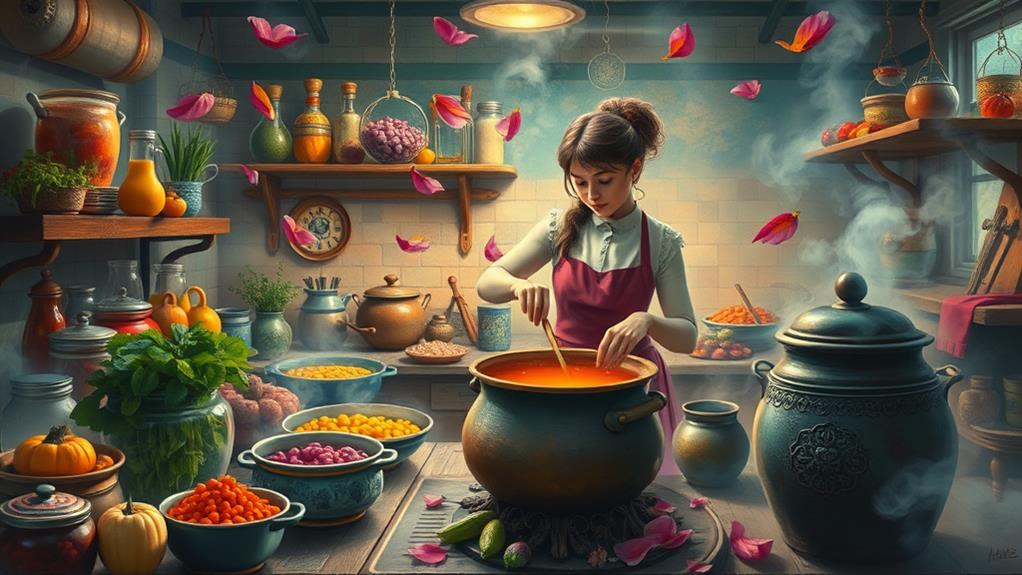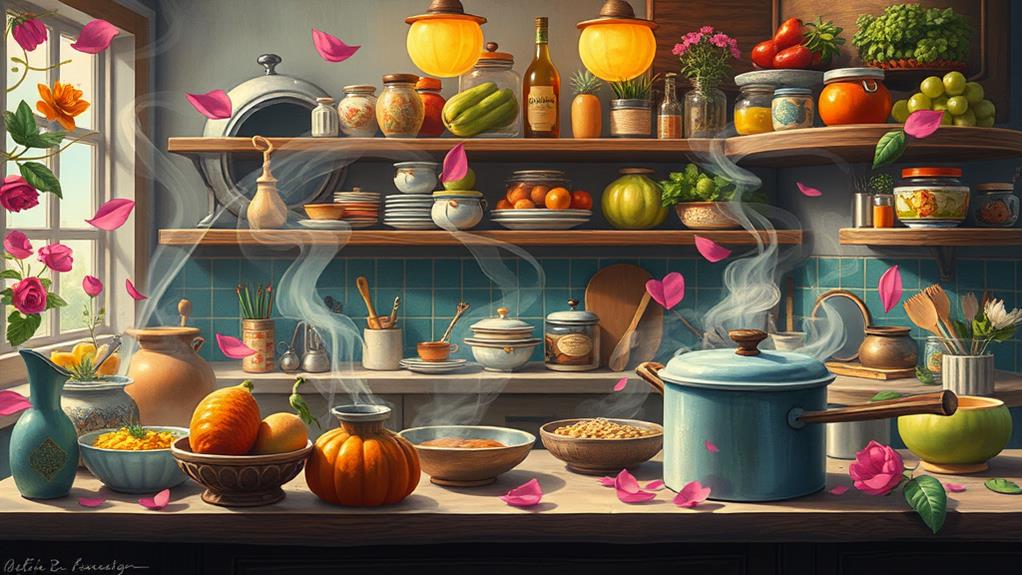In "Like Water for Chocolate," the themes of food, emotion, and magical realism blend beautifully to explore identity and freedom. You'll notice how Tita's cooking symbolizes her struggle for autonomy against oppressive traditions. The narrative uses recipes as emotional touchpoints, embodying Tita's inner world. Magical realism surfaces through extraordinary events that mirror Tita's feelings, adding depth to the story. Gender roles also play a vital role, showcasing Tita's rebellion against societal expectations. Each element intertwines to create a rich landscape of meaning, revealing how love and tradition shape our lives. There's so much more to uncover in this enchanting tale!
Overview of Cultural Context
Set against the tumultuous backdrop of the Mexican Revolution, "Like Water for Chocolate" weaves a rich tapestry of cultural context that highlights the struggles of women during this pivotal time.
The story revolves around Tita, the youngest daughter of the De La Garza family, whose fate is dictated by a family tradition that forbids her from marrying. This reflects the societal expectations placed on women in traditional Mexican culture, where personal desires often clash with rigid norms.
Much like the resilient women highlighted in Unbreakable Non-Fiction Tales, Tita's experience reveals the courage needed to confront and overcome societal adversities. As you explore Tita and Pedro's relationship, you see how their love is shaped by these cultural constraints. Tita's journey embodies the tension between maternal authority and individual longing, illustrating the limitations imposed on female characters.
The use of magical realism enhances the narrative, allowing you to experience the emotional weight of Tita's unfulfilled wishes and societal repression.
Through the lens of these female characters, the novel critiques the oppressive structures that define their lives. By examining Tita's struggles, you gain a deeper understanding of the cultural context that shaped women's roles during the early 20th century, making their stories resonate with contemporary themes of empowerment and resistance.
Themes and Symbolism
In "Like Water for Chocolate," the interplay of food and emotion forms a vital thematic foundation that reveals the complexity of Tita's inner life. Tita's cooking serves as an expression of her emotions, with each dish reflecting her deepest feelings and affecting those who consume them. This culinary magic, coupled with Tita's desire for love, symbolizes her struggle against a restrictive family legacy, illustrating her pursuit of autonomy and self-expression, an essential element in Tita's journey of empowerment.
The symbolism of her bedspread captures her resilience and hope for love amid familial oppression, showcasing her emotional journey.
Recurring motifs of coldness and heat further illustrate the characters' emotional states; heat embodies passion and love, while coldness represents spiritual desolation and isolation. Tita's tears, imbued with supernatural qualities, highlight the depth of female emotions and their tangible impact on reality, reinforcing the magical realism that permeates the narrative.
Additionally, the theme of tradition versus individual desire is prominent, as Tita grapples with her family's rigid customs. This struggle emphasizes the oppressive nature of societal expectations placed on women, illuminating her desire for autonomy and love.
Through these themes and symbols, the novel beautifully illustrates the intricate relationship between emotion, tradition, and the quest for personal fulfillment.
Narrative Techniques

Laura Esquivel skillfully weaves a rich tapestry of narrative techniques in "Like Water for Chocolate," beginning each chapter with a recipe that mirrors Tita's emotional landscape. These recipes serve as structural devices, connecting the characters' feelings with the food they prepare. As you immerse yourself in each chapter, you'll notice how the ingredients and instructions echo Tita's struggles and desires, enhancing the narrative's emotional depth.
This narrative style resonates with the unsung contributions in science and technology, where hidden efforts profoundly shape contemporary experiences.
Esquivel employs exaggerated descriptions throughout the text, immersing you in the sensory experiences of food and emotion. This unique narrative style not only captivates your senses but also deepens your understanding of the themes at play.
The seamless integration of magical realism allows supernatural occurrences to feel perfectly normal, enriching the emotional resonance of the story. By blending personal and historical contexts through these magical elements, Esquivel challenges conventional storytelling, offering a fresh perspective on her characters' experiences.
The interplay of reality and fantasy in the narrative enhances character exploration, illustrating how Tita's emotions directly impact the physical world around her. This dynamic relationship reinforces the overarching themes, making Esquivel's work a compelling study in emotional and magical storytelling.
Magical Realism Elements
Esquivel's narrative techniques seamlessly intertwine with the elements of magical realism in "Like Water for Chocolate." Tita's cooking becomes a powerful expression of her emotions, directly influencing those who partake in her meals. This unique blend of reality and fantasy creates a fascinating experience for readers.
As seen in works like the essence of true love and fragility of life, these emotional connections resonate deeply. Here are some magical realism elements that stand out:
- Tita's Tears: Her tears cause floods in the kitchen, showcasing how emotional experiences manifest physically.
- Food as Emotion: Each dish reflects Tita's feelings, allowing her to communicate her desires and frustrations without words.
- Extraordinary Occurrences: Events like the birth of an unexpected baby or the enchanting aroma of chocolate transcend the ordinary, yet are treated as normal.
- Matter-of-Fact Acceptance: The characters accept supernatural events as part of their reality, blurring the lines between what's possible and impossible.
Through these elements, Tita's cooking embodies the essence of magical realism, enriching the narrative's emotional depth. The interplay of chocolate, emotions, and extraordinary occurrences challenges you to reconsider the boundaries of reality, inviting you to explore the profound connections between food and feeling.
Gender Roles and Identity

Gender roles in "Like Water for Chocolate" aren't just traditional constraints; they're battlegrounds where characters like Tita fight for their identities. Tita courageously defies patriarchal norms, showcasing her strength and resilience as she pursues love and self-expression. Her struggle against her mother's oppressive expectations exemplifies the quest for female empowerment in a rigidly structured society, reflecting the narratives of strong female protagonists in historical fiction who challenge societal limitations empowering narratives and themes.
As Tita channels her emotions into cooking, food becomes a medium for her identity. Each dish she prepares carries her feelings, transforming her culinary art into an act of rebellion. This magic realism element illustrates how her identity transcends conventional gender roles, highlighting the power of self-expression.
Interestingly, Pedro Muzquiz, who initially embodies traditional masculinity, reveals vulnerability that blurs the lines between gender expectations. This fluidity of identity suggests that love and passion can reshape characters, allowing them to break free from societal constraints.
Ultimately, "Like Water for Chocolate" not only critiques the rigid gender roles of its time but also celebrates the transformative power of self-discovery and emotional expression. Through Tita's journey, you see how challenging these norms can lead to a deeper understanding of oneself and the redefinition of identity.
Conclusion
So, if you ever thought cooking was just about flavors and recipes, think again! "Like Water for Chocolate" proves it's really a complex recipe of love, gender roles, and magic. You're not just simmering ingredients; you're stirring up emotions and societal critiques. In a world where food can ignite passion or spark rebellion, who knew the kitchen could be the hottest battleground? Immerse yourself in this tale, and you might just find your own recipe for magic!



